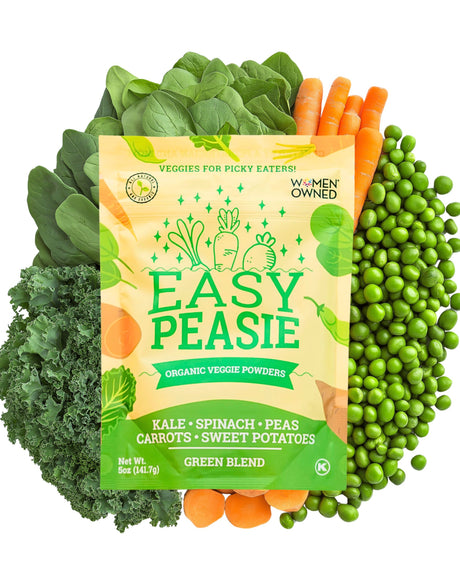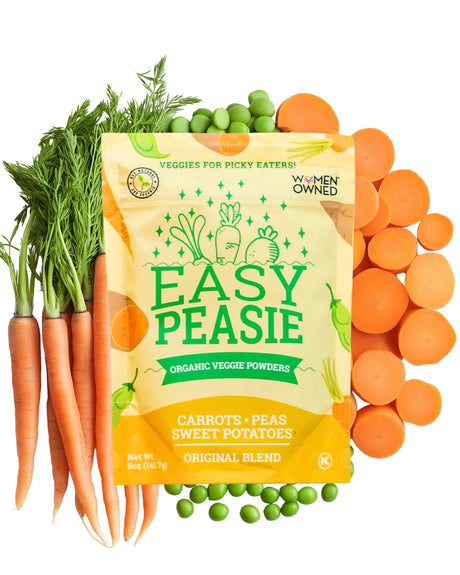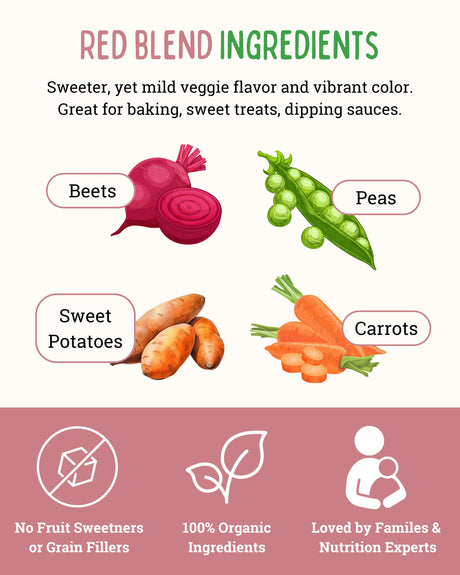Toddlers and Their Food Favorites
It's a scene many parents are all too familiar with: mealtime rolls around, and your eager toddler only has eyes for one dish, dismissing the colorful array of other foods you've lovingly prepared.
Whether it's mac and cheese, chicken nuggets, or a specific fruit, these little ones can be fiercely loyal to their chosen favorites. It's as if the rest of the culinary world fades into the background when that one dish is in sight.
A Parent's Mealtime Dilemma
For parents, this unwavering dedication to a single food can be a source of both amusement and anxiety. While it's endearing to see their little one's enthusiasm for a particular dish, there's that nagging worry: "Is it okay for them to eat the same thing every day?" "Am I failing to provide them with the varied nutrients they need?"
These concerns are especially prevalent for parents who are deeply invested in their child's nutrition and overall well-being. The quest for answers and solutions begins, as they wonder how to navigate this phase of selective eating.

The Psychology Behind Food Preferences in Toddlers
Navigating the Toddler Developmental Stage
The toddler years are a whirlwind of growth, exploration, and self-discovery. As these little ones begin to assert their independence, they're also trying to make sense of the world around them.
Everything is new, everything is an adventure, and with that comes a natural inclination to seek comfort in the familiar. This developmental stage is marked by rapid cognitive and emotional growth, and it's no surprise that their approach to food mirrors this journey of exploration and boundary-setting.
The Comfort of Familiar Foods
Amidst the vast array of new experiences, familiar foods offer a comforting constant for toddlers. Just as they might have a favorite toy or bedtime story, a preferred food becomes a source of solace and predictability in their ever-changing world.
This gravitation towards certain foods isn't necessarily a sign of defiance or stubbornness. Instead, it's a reflection of their need for stability. When they choose that same dish time and again, they're not just seeking the taste of the food, but also the comfort and security it represents in their young lives. For them, it's a small piece of the world they've figured out, and there's immense satisfaction in that.
Nutritional Implications
The Significance of a Varied Diet for Toddlers
Diversity in a toddler's diet is more than just a culinary journey; it's essential for their health. As these youngsters grow rapidly, they need a wide array of nutrients.
Each food group brings its unique set of benefits. Whole grains, for instance, offer energy-sustaining carbohydrates. In contrast, fruits and vegetables are packed with vital vitamins and antioxidants. Proteins play a pivotal role in muscle and tissue development. By introducing a variety of foods, we're not just tantalizing their taste buds but ensuring their comprehensive growth.
Navigating the Nutritional Gaps
Relying heavily on a single food can lead to nutritional gaps. Consider a child fixated on pasta. They might get ample carbohydrates but could miss out on essential fats from avocados or fish. Over time, such gaps can impact their overall health and cognitive development.
The Bigger Nutritional Picture
Think of it this way: reading the same book page daily means they know it well but miss the broader story. Similarly, while a favorite food has its nutritional merits, it's the combination of diverse foods that truly nourishes a toddler.
The Role of Exposure in Developing Food Preferences
The "Try It At Least 10 Times" Rule
It's a familiar scene: a toddler turning up their nose at a new food. But before giving up, consider the "try it at least 10 times" rule. This principle, rooted in patience and persistence, suggests that children might need multiple encounters with a food before they warm up to it.
It's not about pressuring them but rather offering gentle, repeated introductions.
The Magic of Repetition
There's a method to this repetition madness. Each exposure, even if it's just a tiny nibble or a curious lick, familiarizes the child with the food's texture, aroma, and taste.
Over time, what was once foreign becomes familiar. It's akin to hearing a new song; the first time might feel jarring, but with repeated listens, you might find yourself humming along.
From Resistance to Acceptance
It's a journey from the first skeptical glance to eventual acceptance. And while it might not always lead to a newfound favorite, the goal is broader palate exposure.
Remember, it's not about the quantity they consume during these trials but the consistent exposure that gradually shifts their food perceptions.
Strategies to Introduce Variety
Making Mealtime Fun: The Art of Presentation
The way food is presented can make a world of difference to a toddler's eyes. Think vibrant plates, playful shapes, and a splash of color.
A sandwich might be mundane, but when it's cut into a star or heart shape? Suddenly, it's a delightful treat. Using cookie cutters or arranging veggies into a smiley face can transform the ordinary into an exciting mealtime adventure.

Little Chefs in the Making: Involving Toddlers in Cooking
There's something magical about being part of the creation process. When toddlers get to wash the veggies, stir the pot, or even just sprinkle some herbs, they develop a sense of ownership over the dish.
This involvement not only fosters a love for cooking but also piques their curiosity to taste what they've helped make.
A Gentle Introduction: Pairing New with the Familiar
Diving headfirst into unfamiliar territory can be daunting for anyone, toddlers included. When introducing a new food, pair it with something they already love.
If pasta is a favorite, maybe add a few pieces of a new veggie to the sauce. This way, the unfamiliar becomes a subtle addition to a trusted favorite, making the transition smoother and less intimidating.
Benefits of Using Products like EasyPeasie Veggie Blends
Complementing the "Try It At Least 10 Times" Rule
Incorporating EasyPeasie into meals aligns perfectly with the principle of repeated exposure. While introducing new vegetables directly might meet resistance, sprinkling veggie powder into familiar dishes can be a subtle way to familiarize toddlers with new tastes.
Over time, as the flavor becomes more recognizable, children may become more open to trying the actual vegetable.
The Magic of Repetition with a Nutritional Boost
Repetition is key in developing a child's palate, and EasyPeasie offers a consistent way to do so. By regularly adding this veggie powder to beloved recipes, parents ensure that their kids are repeatedly exposed to the nutritional goodness of vegetables, even if they're not directly consuming the whole veggie.
This repeated exposure, combined with the nutrients packed in the powder, amplifies the benefits of the magic of repetition.
Pairing New with the Familiar: A Gentle Introduction
EasyPeasie is all about complementing what your child already loves. By blending the veggie powder into favorite dishes, parents can introduce new nutrients without straying too far from familiar tastes.
It's a gentle nudge towards healthier eating habits, ensuring that the new is always paired with the familiar, making the transition smoother and more acceptable for picky eaters.
When to Be Concerned
Spotting the Signs: Beyond Typical Picky Eating
Every child goes through phases of being finicky with food, but there are certain signs that might indicate a deeper feeding issue. If your toddler consistently gags at the sight or texture of certain foods, or if there's a drastic weight change, it could be a cause for concern.
Additionally, if mealtime consistently becomes a battleground filled with distress and tears, it might be more than just a dislike for broccoli.
Phase or Persistent Problem? Understanding the Difference
It's essential to differentiate between a temporary phase and a more persistent issue. While it's common for toddlers to have their food favorites for a week and then suddenly change their minds, if this pattern continues for months or if the list of accepted foods keeps shrinking, it might be time to seek guidance.
Remember, it's always better to address potential concerns earlier rather than later, ensuring your child's nutritional and emotional well-being.
Seeking Professional Guidance
Consulting the Experts: Pediatrician or Nutritionist
Every child is unique, and while some picky eating phases are common, there are moments when a parent's intuition tells them it might be more than just a phase. If you find yourself constantly worried about your child's nutritional intake or if their food aversions seem extreme, it might be time to seek expert advice.
Pediatricians and nutritionists are equipped with the knowledge to assess if a child's eating habits are cause for concern. They can provide tailored recommendations, ensuring that your little one is getting all the essential nutrients they need for healthy growth.

Feeding Therapy: Beyond the Basics
For some children, the challenges around eating go beyond the usual picky eater scenario. This is where feeding therapy comes into play. It's a specialized approach that delves deeper into the reasons behind a child's aversion to certain foods, be it due to taste, texture, or past negative experiences.
Feeding therapists work closely with children and their families, using various techniques to address and overcome feeding difficulties. Whether it's helping a child navigate sensory issues or providing strategies to make mealtime less stressful, feeding therapy can be a game-changer for families facing significant feeding challenges.
Final Thoughts
The Virtue of Patience and Persistence
Navigating the world of toddler nutrition is no small feat. As parents, it's natural to feel a mix of concern, frustration, and sometimes even guilt when faced with a little one who's resistant to trying new foods.
But remember, developing a palate is a journey, not a destination. Just as toddlers grow and evolve, so too will their food preferences. With patience and persistence, those once-rejected veggies might just become a favorite in the future.
Staying Informed and Embracing Flexibility
In the ever-evolving landscape of parenting, staying informed is key. Whether it's reading up on the latest nutritional guidelines, seeking advice from experts, or simply connecting with other parents, knowledge is power. But equally important is flexibility.
Every child is unique, and what works for one might not work for another. By staying adaptable in your approach, celebrating small victories, and remembering that you're not alone in this journey, you're setting the stage for a positive, healthy relationship with food for your child.
Additional Resources
Dive Deeper with Recommended Readings
For those eager to delve deeper into the world of toddler nutrition, there's a wealth of knowledge waiting to be uncovered. Books like "Child of Mine: Feeding with Love and Good Sense" by Ellyn Satter and "It's Not About the Broccoli" by Dina Rose offer invaluable insights into understanding and navigating the often tricky terrain of kids' eating habits.
These readings not only provide practical advice but also empower parents with the understanding and confidence to make informed decisions.
Tech to the Rescue: Apps and Tools
In our digital age, there's an app for almost everything, and toddler nutrition is no exception. Apps like "Yummly" offer tailored meal plans and recipes catering to young palates, while "MyPlate" by Livestrong allows parents to track their child's nutritional intake, ensuring they're getting a balanced diet.
For those looking to make meal planning a breeze, "Mealime" is a fantastic tool, offering easy-to-follow recipes and grocery lists tailored to your family's preferences and dietary needs. With these tools at your fingertips, ensuring your toddler gets the best nutrition becomes a more manageable and stress-free task.













